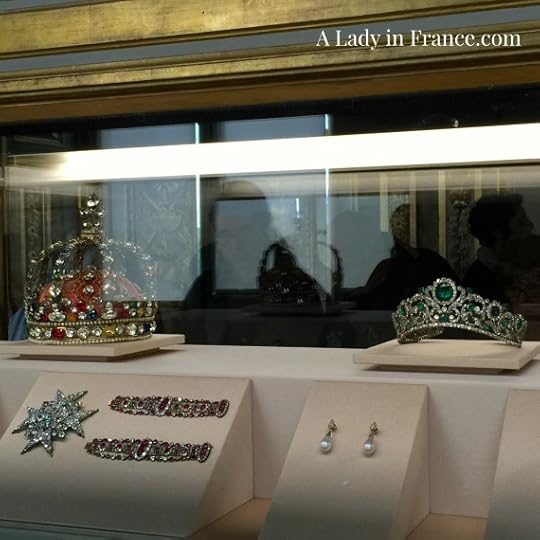Jennie Goutet's Blog: A Lady in France, page 24
June 12, 2015
Ask Me a Question About the Bible
Now that I’ve officially announced everywhere that I won’t be continuing to teach next year so that I can consecrate myself fully to writing (and to my kids, who are growing up), I have all sorts of blogging and book ideas.
For those of you who see “Bible” in the title and are sort of meh over my faith posts, but love the French stuff – don’t worry! I do intend to continue publishing my usual types of posts.
Speaking of all sorts of blogging ideas, in case you missed it, there will be a photo linkup on Wednesdays (that you can participate in either through Instagram or your blog). It’s to get people (aka – me!) off the couch, and the goal is to take a picture of somewhere you went outside of your own home and garden. I will be featuring one participant each week, as long as you use the hashtag and/or include the button.
So this idea has taken hold to put out a call for any questions people might have about Christianity or the Bible, and do a weekly post answering those questions. You can ask me something either in the comment section, on the A Lady in France FB page, or – if you want to remain anonymous – by sending me an e-mail (address in the About page). In any case, I will just use your first name when I post your question.

So. Who am I to answer questions about the Bible?
Well. No one really.
But the Bible does say in Romans 15:14 ‘I myself am convinced, my brothers and sisters, that you yourselves are full of goodness, filled with knowledge and competent to instruct one another.’ And I have 20 years of reading the Bible, studying the Bible, teaching the Bible, and (more importantly) putting it into practice.
What can you expect from my answers?
– that I will pray before responding
– that if I don’t know the answer I will tell you, or will seek guidance from people whose life and doctrine I trust
– that my life will match my doctrine (and that I’m being open with the people in my life)
– that I’ll be open to correction in the comments section (and if I am convinced Biblically that I am in error, that I will correct my post).
– that if I feel like I’m starting to go beyond what is written or get in over my head, I will stop the series.
So that’s what you can expect from me. But what about you? Do any of you have questions? Or is this series doomed to fizzle before it takes off? 
June 10, 2015
Instagram Photo Linkup
I have decided to start a new weekly photo linkup called, “Hit the Road, Jack” to motivate me to leave the house. Each week I will go somewhere – anywhere – (I mean, I do live right near Paris, after all) and take pictures of what I see there. Maybe you would like to do the same?
It doesn’t have to be exotic. In fact, you may not think where you live is all that exotic but it probably is to those of us who don’t live there. Show me your farms, your suburbs, your cities, your quiet lanes, your noisy streets, your local hangouts … As long as it’s not in your own home or garden, it counts. Let’s get off the couch together!
There are no real rules, other than the “leave your property” rule if you want to play along. You can imbed Instagram photos of where you’ve been (maybe get some new Instagram followers that way?) or just upload pictures to your posts the old-fashioned way. You can include one photo or many; no text, or a guided tour. Just add the Hit the Road, Jack button to your post so people can come here and find the link. If you don’t have a blog, tweet your Instagram post with the hashtag so I can see it.
Oh yes! The hashtag! Make your posts more visible to everyone who is following, by promoting with the hashtag #HTRJack
The blogs in the linkytool below will appear in random order so everyone is fair game. You don’t know who was here first. Since everyone has an equal shot of being visited, woo people by making your thumbnail shot and title appealing! 
June 8, 2015
5-Layer Bean Dip
This 5-layer bean dip is not French by a long shot, and is therefore not a recipe I thought to share with you. Also, I thought everyone knew how to make it so what’s the point of doing the recipe?
Except that I found that – not only does everyone not know how to make it, but some people don’t even know what it is? (I’m mainly talking to the Americans here). What about you? American or not, do you know what this is? Do you know how to make it? And more importantly … would you want to?

This is the simplest recipe in the world, and if you have access to refried beans (hello Texans), it’s even simpler. Here in France we don’t, so I make my own. Honestly, I don’t even know if this is a legit refried beans recipe. It’s just one that makes sense to me.
You need some beans (and olives, and salsa, and sour cream, and cheddar).
 Fry up an onion and 2-4 cloves of garlic in 1T of olive oil.
Fry up an onion and 2-4 cloves of garlic in 1T of olive oil.
 Rinse the beans – get rid of all that stomach-expanding foam.
Rinse the beans – get rid of all that stomach-expanding foam.
 When the onion and garlic mix is brown, add the beans and fry for about 10 minutes. You don’t need to add salt because the canned beans have salt. And the olives have salt. And the salsa has salt. And the cheddar has salt … you get my drift.
When the onion and garlic mix is brown, add the beans and fry for about 10 minutes. You don’t need to add salt because the canned beans have salt. And the olives have salt. And the salsa has salt. And the cheddar has salt … you get my drift.
 Put the beans in the Cuisinart with a cup of water. Purée it.
Put the beans in the Cuisinart with a cup of water. Purée it.
 And then re-fry them! (See what I did there)?
And then re-fry them! (See what I did there)? 
June 4, 2015
Author News, Blogging News
I have made some author and blogging decisions lately that almost warrant being called news. And since we’re friends, you and I, it’s time to fill you in. (Plus, I can’t seem to get my act together and write my family, so this way they’ll get news too). 
June 1, 2015
God is Kind
God is kind to the Israelites as he frees them from slavery, sparing their first-born sons, and parting a massive body of water so they could go through – young, old, men, women and children. Not one is lost. (Exodus 1- 15).
God is kind to his people as he makes bitter water sweet so they do not die of thirst in the desert. He rains manna from heaven every day, which “tasted like wafers made from honey”, and brings quail in the evenings so they would not die of hunger. He is kind as he brings water from a rock. He is kind as he gives the people victory against the invading Amalekites. (Exodus 16 and 17).
He is kind as he meets with Moses, face to face, on Mount Sinai – protecting the Israelites from his glory, which could kill them – but helping his people to put their trust in the leader chosen for them by witnessing the dark cloud, thunder and lightening, trembling mountain, the trumpet blasts growing louder and louder … and Moses coming out of the cloud unscathed. (Exodus 19).

God is Kind – a post by @aladyinfrance
In the three months it took for the Israelites to cross the Red Sea and arrive in the desert at the foot of Mount Sinai, God showed nothing but goodness and loving kindness.
I’ve been thinking of God’s kindness lately. I’ve mentioned our plans to refinance a toxic loan and build a second story so that each kid will have his own room. We had one good loan at 3.5% and one toxic loan at 4.5% (where we pay only interest and none of the capital). We were excited that, with the low interest rates, we were able to get 2.0% to refinance with another bank, along with a separate loan for the construction at 2.5%. We started the process in September.
But because of a bank paper that would not come – an official paper from our old bank stating that our initial loan for the apartment was indeed transferred over to our current property – we were unable to transfer the loans and unable to start the work.
The new bank called us often to see where we stood. Our construction company began to give up on us as months went by and we had no news. Finally (I mentioned this in an earlier post), just when we were promised the paper, our banker collapsed at work and was hospitalised with no promise of returning. She was our only support so we were back at square one.
In that time, because of the delay, the new bank dropped its offer to 1.9%. Great! Except we still had no paper so we couldn’t take advantage of it. And then, just as the news announced that the interest rates were about to go up, I decided to look through every single paper we owned to see if I could find something that would suffice.
I was successful! And we got another appointment with the new bank, where we were given an even lower rate of 1.6% for our house loan, and 2.2% for the construction. All that waiting had paid off because we got an offer that was even better! I had been so mad at God because I felt forgotten. I felt like he wasn’t listening, and meanwhile he was just saying, “Wait. Trust me. I have something better in mind.”
I know about the 40 days Moses spent on Mount Sinai, where he was given The Ten Commandments. I know about the people growing tired of waiting, and throwing their jewellery into the fire to make a golden calf so they could fall down and worship. (Stoopid people).
But what I hadn’t realised was that Aaron and his two sons had gotten a lot closer to God than I initially thought. And so had SEVENTY of the elders of Israel.
Moses and Aaron, Nadab and Abihu, and the seventy elders of Israel went up and saw the God of Israel. Under his feet was something like a pavement made of lapis lazuli, as bright blue as the sky. But God did not raise his hand against these leaders of the Israelites; they saw God, and they ate and drank. (Exodus 24:9-11)
They ATE and DRANK with God! They saw him! So what excuse, then, did they have when Moses was up in the mountain, communing with God, and they were down building an idol to worship? Seventy-three religious leaders and they couldn’t influence the people to stay faithful?
When Moses approached the camp and saw the calf and the dancing, his anger burned and he threw the tablets out of his hands, breaking them to pieces at the foot of the mountain. And he took the calf the people had made and burned it in the fire; then he ground it to powder, scattered it on the water and made the Israelites drink it.
He said to Aaron, “What did these people do to you, that you led them into such great sin?”
“Do not be angry, my lord,” Aaron answered. “You know how prone these people are to evil. They said to me, ‘Make us gods who will go before us. As for this fellow Moses who brought us up out of Egypt, we don’t know what has happened to him.’ So I told them, ‘Whoever has any gold jewelry, take it off.’ Then they gave me the gold, and I threw it into the fire, and out came this calf!” (Exodus 32:19-24)
“As for ‘this fellow Moses …”
“… and out came this calf!”
Really? REALLY?
Our appointment with the bank, and all its good news, was on Thursday. All I kept thinking that day was, “God, you are so kind. You are so KIND to us.” My heart melted over his goodness towards us, his loving-kindness, even when I hadn’t trusted him.
On Friday – the very next day – was our appointment with the sous-préfecture, which is like a local consulate. I had grown tired of having to get residency cards and decided to shoot for French citizenship so I would have dual nationality. I prepared the papers in triplicate – the originals plus two photocopies. I put each in a clear folder, labeled “originals” “copie 1″ “copie 2″. I wasn’t going to miss a thing!
It had taken some time, but I finally amassed the birth certificates for my three kids, myself, my husband, my mom and dad, our marriage. I got all the overseas docs officially translated. We collected our last 3 tax statements, along with all the documents proving continual residency in France, and communal life. We were ready!
But I didn’t get an apostille on my birth certificate – that raised, reflective, stamp of authentication that can only be attained through the Secretary of State from where you were born (and not from the place where you get your birth certificate). I didn’t get the apostille because the extensive, thorough website detailing everything I would need for naturalisation DID NOT SAY TO GET ONE.
Can you sense my frustration? I was – am – frustrated. Since all the birth certificates have to be dated within 3 months, we’re going to have to order them all again so that we have correctly dated copies by the time the apostille arrives in the mail. My friendliness evaporated, and it was a hard, angry face that I presented to the government worker. My diplomatic husband said, “It would be great if you could specify on the website that an apostille is needed for the applicant’s birth certificate.”
When we got outside, rejected papers in hand (in triplicate), all I could do was to swear in my head, repeatedly. @#$%&! @#$%&! @#$%&!
“I don’t even know if I want to become a citizen of this stupid country. Only in France would they reject you for not having something they didn’t even specify as necessary!”
Matthieu, who had gone through the green-card process in New York, just laughed and shook his head. “Trust me …”
I was so mad at God for frustrating my efforts, all I could do was curse. But while I was cursing (in my head), I was conscious that just one day earlier I had been praising him for his kindness. It took the Israelites 40 days to forget everything God had done for them.
It took me only one.
It was like swallowing bile, but I knew I needed to apologise to God for how quickly I had forgotten his goodness. In just one day I was already mad at him for not giving me what I thought I deserved. Later on, when reflecting on his kindness, I saw this scripture in a way I had never seen before because I always focused on the first part of the scripture and not the last.
But love your enemies, do good to them, and lend to them without expecting to get anything back. Then your reward will be great, and you will be children of the Most High, because he is kind to the ungrateful and wicked. Be merciful, just as your Father is merciful. (Luke 6:35-36).
He is kind to the ungrateful.
WOW. Ouch. Yeah, that would be me.
But even when all evidence seems to the contrary, God remains kind! His nature doesn’t change.
Thank God for that!

Droit d’auteur: spetenfia / 123RF Banque d’images
The post God is Kind appeared first on A Lady In France.
May 29, 2015
Easy Osso Bucco Recipe
Osso Bucco is an easy, elegant recipe to serve to guests. I don’t know about you, but when I think of osso bucco, I immediately think of The Office when Michael Scott and Jan were on the last legs of their dysfunctional relationship, and they invited a bunch of people over to attend a very uncomfortable dinner, full of awkward silences. If that weren’t enough, Jan was making osso bucco, which had to cook for 6 hours, and she had only just started cooking the dish.
Humor aside, this episode gave the impression that osso bucco is something hugely complicated to make. But it’s not.

Osso bucco is Italian for “bone with a hole.” It’s a peasant dish that was traditionally made with a creamy sauce, but is now more popular to make with tomatoes. It has a very mild flavour and you can make it with veal shanks or slices of turkey leg. I’m making mine with turkey.
Salt and pepper the meat, and put some flour on a plate. Dredge the meat in the flour, coating it on all sides, and then heat a large skillet with a couple of tablespoons of olive oil. Brown the meat a few minutes on each side.

I like to purée my vegetables and seasoning, so I puréed one large onion, 2 stalks of celery, and 8 cloves of garlic. I put some more olive oil in a large sauce pan and browned this mixture. Some recipes call for carrots, but I don’t like carrots in dishes that use tomatoes.

When the mixture is brown, add 2 cups of white wine. Mine is alcohol free, but it still contributes to the flavour. Add a few bay leaves and a sprig of thyme (or 2 teaspoons dried thyme). Reduce the wine by heating the wine-onion mix on high heat, stirring often.

When it’s reduced (less liquid), place the meat on top.

Cover with 4 cups of beef bouillon. You can use chicken or vegetable as well. Now you’ll want to cook it on low heat uncovered for 1.5 to 2 hours – the longer the better.

Meanwhile, zest an orange and two lemons (I assume this would not be in the traditional peasant recipe, but it adds a perfect extra touch).

Add the zest towards the end of the cooking time.

Then add a can of crushed tomatoes and a can of tomato paste (the paste should be smaller in size). And your dish is ready to serve to your guests!
If you’re feeling stressed about preparing this, you can brown the meat and purée the onion mix earlier in the day, and store them in the fridge. That way you only have to add the liquid and start simmering two hours before your guests come. It’s stress-free!

Serve it with rice, and if you need a tutorial for making rice, there is one right here.
See? I think of everything. 
May 27, 2015
Reviewing Open Boxes
Christine Organ’s Open Boxes reads a little bit like Ann Voskamp’s One Thousand Gifts. I mean, I don’t get the sense that she was influenced by Voskamp, and Organ clearly has her own style of writing (which is beautiful), but as I was reading it, I was reminded with gentle nudges to appreciate the small moments – the thousand gifts that come to one in daily life, if only you can see them.

Open Boxes is divided into sections which direct the reader’s attention to grace, miracles and wonder; and she shares snippets of her life, which illustrate the themes. Most of these vignettes made me feel a connection to her, and I appreciated how much we have in common:
Puppy woes (although theirs had a happier ending)
PPD
Competitive swimming as a kid
Struggle with traditional faith
Body image and trying to fit in
Also – the way a writer’s thoughts work, as well as the process to get those thoughts on paper, and the highs and lows of it all. I related so much to that part.
She’s so down-to-earth, I imagine a lot of people who read her book discover this feeling of shared humanity. And her overtures in connection and vulnerability are the perfect backdrop to the theme of “open boxes.” We are not to compartmentalise our own lives, and we shouldn’t close off from others who don’t seem at first glance to be like us. (That’s me reading her message between the lines).
Organ’s faith took a different path than mine, and this was the only part that I didn’t connect to – the universal unitarian aspect of religion that the author believes in. You guys who know me, know that I’m fundamental when it comes to scriptures (but very liberal when it comes to love). I wrestled in my faith to get to that point, and this issue of all roads lead to the same happy ending was a mild distraction for me. But I’m expressing this more as an afterthought – trying to give a really honest opinion of the book – not say it as a deterrent to reading it. I was always grateful when my “non-religion” or “other-religion” friends and readers would read my memoir, with its strong undercurrent of faith, and still find the connection – still love me anyway. Organ’s words deserve that too.
With the author there’s lots to love. You get the sense that you would be good friends if you only lived nearby. Her struggles are relatable – sometimes funny, sometimes making you tear up in sympathy. I actually quoted from the book. When a friend came to me for help in getting her anger under control, I told a story in which Organ responded with such grace and gentleness to an acerbic, impossible person. (This is my understanding based on her description of the event – not the author tooting her own horn). I shared about what a difference it made to someone who had witnessed the entire exchange when she remained full of grace. My friend was inspired to speak more gently to people, based on the story.
I also remembered the book when I was out with my son’s class at a “tree museum.” I was tempted to feel anxious about being stuck on a class trip for several hours (I’ll never win Parent of the Year), but instead I prayed to find wonder in the experience. That day, the entire class of 6-year olds scattered all across the meadow with their paper and pencils to sketch the trees. And I sat down and did the same. I felt six again.  I felt … wonder.
I felt … wonder.
I would quote phrases from the book for you if it were convenient to cut and paste the quotes that struck me. Instead, I’ll just say that any book that makes you smile or tear up, that you use as an example for someone seeking advice, that you remember in a moment when you want to direct your own thoughts higher; any book in which you’re struck by a turn of phrase that’s particularly lovely so that it stays with you … this is the kind of book you can recommend. This is the kind of book that’s worth reading.
I was given a copy of Open Boxes in exchange for a review. Clearly no one else told me what I should write.
* * *
I know I’ve been posting a lot this week. All sorts of renewed blogging energy while I sort out my plans for my book. BUT. I was also featured on BonBonBreak with an original post on the future of small bloggers. (Like me). I’d love for you to read it – HERE!
The post Reviewing Open Boxes appeared first on A Lady In France.
May 26, 2015
Book Bundle from #MomsWhoWrite
For five days (until May 30) there is a book bundle for sale where you get 7 books for $9.99. All the books are written by moms, and most of them are how-tos. My memoir is the odd-ball on this list 
May 25, 2015
Remembering the Soldiers of Omaha Beach
We visited Omaha Beach four years ago, and this is a condensed version of a blog post that appeared on my blog after the visit. It seemed appropriate for Memorial Day.

A Germany that was humiliated and impoverished after World War I was ripe for someone as charismatic and patriotic as Adolf Hitler. On January 30, President von Hindenburg appointed Hitler German Chancellor. Within four months of his appointment, the Nazis were already boycotting Jewish shops and burning their books.
A year and a half later, in the Night of the Long Knives, Hitler assassinates more than 1000 of his political opponents, and he declares himself Furher – Guide. A year later, Jews are relegated to second class citizens and are unable to marry or have relations with Germans.
Germany creates an alliance with Japan and Italy as a first step towards world domination.
Following the murder of a German diplomat by a French Jew in Paris, Jewish stores are looted, 91 Jews are killed, and 20,000 are taken to concentration camps.
For about a year and a half, France remains in a state of war with Germany, but it consists largely of propaganda, and nothing of actual battles. The French generals are used to the trench warfare of World War I, and spend all their efforts fortifying and protecting the border between France and Germany in what is called the Maginot Line. Charles de Gaulle tries to warn the French about the Panzer – the extensive tanks the Germans are building – but nobody listens to him. He eventually flees to England and leads the French Resistance from there.
Germany pushes through the forests of Belgium and Luxembourg to cut off the Allies who have advanced into Belgium. My husband’s grandfather rushes to assemble on the Belgian border, along with other divisions of the unprepared French army. On June 5th, Germany goes swiftly around the Maginot Line and conquers France. The invasion is called “the debacle.”
The Japanese bomb Pearl Harbor because of the fuel embargo imposed upon them for their involvement in the South Pacific, finally forcing the US into the war. Shortly afterwards, Germany declares war on the US because of its treaty with the Japanese, and that coincides with US interests to enter the European theatre. They have already been assisting the British by lending materials, and engaging in secret warfare against Germany.
The President, along with his Joint Chiefs of Staff, coordinate strategy with the British. Winston Churchill foresees that the key to overcoming Germany is to enter France through the formidable Normandy beaches. As unfriendly as they are, they are the least heavily guarded.
Churchill orders the construction of massive beachheads that would allow ships to bring tanks, ammunition, troops and other support into France. They would extend from the beach out to sea and provide a series of fixed and floating ramps to deposit materials and return for more.

He begins making plans for a major Allied invasion across the channel. Hitler is prepared for one, but assumes the Normandy beaches will be too difficult, and has his General, Erwin Rommel, shore up the defenses on the Atlantic coast.
For two years the Allies plan the attack and build the beachheads that would allow them to import everything they need for an extended war. They pinpoint the best day to attack, based on the low tides that would allow the ships to spot, and avoid, the mines planted by the Germans, and based on a full moon for better visibility once the troops were on the ground.
In May, the weather is auspicious, but it starts to turn at the beginning of June with heavy rain, gales of wind and high tides. The Allies are afraid they will have to push the invasion off for another month, which would have been nearly impossible as preparatory measures were already well underway. Finally, the team of meteorologists call for a slight improvement on June 6th, a day later than the invasion had been planned.
The final consent falls to General Eisenhower who has one night to make his decision. He wrestles with it that night, unable to sleep. He knows what heavy casualties the US would sustain in the best of conditions, but the weather is unpredictable, which could make the outcome catastrophic. Yet, the slight improvement in weather might be the only window they have. The next morning he sits silently in the room with the Allied forces for, what some would say was a full five minutes, though to him it felt like just 45 seconds.
Finally Eisenhower speaks. “I say we go.” In two seconds the room clears as people scurry away to begin preparations.
The General visits the troops before they are about to embark; and upon seeing him, they greet him cheerfully, saying, “Don’t worry General; we’ll take care of this thing for you.” He is encouraged by their fearlessness, and confident of victory.
Shortly after midnight, thousands of paratroopers and glider troops are being flown in and dropped behind enemy lines. They are to secure bridges and other strongholds, and be ready to close ranks with the soldiers invading from the beaches.
At 6:30 in the morning, the largest amphibious invasion in history begins. The US is responsible for taking Utah beach, and they erroneously land about a mile South of their projected target. This is a fortuitous error as the area is less heavily defended by the Germans and they are the least hit. The following divisions for Utah Beach are ordered to land in this new location.
The Canadians are responsible for Juno Beach to support the British troops taking Sword Beach to the East, and Gold Beach to the West. They are then to provide support for the British taking of Caen, as well as to capture the German airfield to the West. They are hit quite hard in the first wave as the air bombardment preceding the attack had been less successful than planned, and the first wave of relief troops was delayed by the tide. Yet the Canadians push forward and secure the beach in two hours.
The British take Sword and Gold beaches with lighter opposition, but they still lose 1000 men between the two beaches due to the heavily mined shores and the remaining German resistance that had not been taken out by the aerial bombardment.

And that leaves the invasion that suffered the most casualties. Omaha Beach.

There is simply no protection from enemy fire coming from above.

The beach is vast, and the enemy in prime position above the hill. The troops pour in and take cover at the foot of the cliff, or under what obstacles they find, but they are still slaughtered.
Within ten minutes of the first company landing, every officer and sergeant has been killed or wounded and it becomes a struggle for survival, rather than a coherently directed operation.

Meanwhile, a group of 225 Rangers are sent to scale Pointe du Hoc:

a steep cliff that holds the German defense believed to cover both Utah Beach to the East and Omaha Beach to the West. It is a key target, but very difficult to take. The Rangers scale the cliffs with special climbing equipment, despite being shot at and having grenades thrown at them from the Germans.
They reach the summit to find that a large amount of the German defenses had been annihilated by the air attacks, and the ground filled with craters from the recent, intense preparatory bombing.

To their surprise, the rangers find that the casements are empty.

The Germans had already moved their artillery to another location. The Rangers cautiously pick their way through the quiet countryside. Only 155 of them have survived the initial attack on the steep cliffs. They discover the cache of artillery, well camouflaged about a half mile away, and secure it.

The Rangers resist increasingly heavy German counterattack for 36 hours. Due to navigational errors their mission is thought to have failed, and by the time the Rangers are finally relieved, there are only 90 men left.
At 10:30 that night, Arromanches is liberated, making way for 170,000 troops to come across the beachheads and push their way through Normandy. On August 25, 1944, Germany surrenders.
Of all the Normandy invasions on D-Day, Omaha beach sustained the heaviest casualties, with the death of 2000 American soldiers.

When I visit these places, why does my throat ache? Why do my eyes sting? I am not insensible to the wars that are going on even now, to the wars that occurred well after this one that took place 60 years ago.
I am American. I married a French man and my sister married a German man.

In this day and age, that is unremarkable.
But here in the Normandy beaches, buffeted by history, the tide of my blood and my roots crashes with that of my home and my life.

And the story it tells roars in my ears.
* * *
We visited Omaha Beach, Pointe du Hoc, the American Cemetery and the museum of Arromanches, which gives the history of the beachheads designed by Churchill. There is also a little free train in Arromanches that leaves every half hour to take you to a theatre on the hill that shows an 18 minute circular movie with footage from World War II. I got my information from the museums, and from these websites: here, here and here.
I am not a historian, so if I have unintentionally misrepresented facts, please feel free to correct me in the comment section.
The post Remembering the Soldiers of Omaha Beach appeared first on A Lady In France.
May 22, 2015
A Virtual Tour of the Louvre
Hi friends! Want to take a virtual tour of the Louvre with me? I’ll give you fair warning that we’re only visiting the 1st and 2nd floors today because we have lunch plans in the Latin Quarter. But that’s fine. It’s not a wasted trip. The Louvre is never a wasted trip.

When you go, take the train to Metro line 1, Stop: Palais Royal Musée. Exit – but stay in the subway tunnel and follow the crowd to the Louvre entrance underground. That way you’re waiting in a protected area, surrounded by luxury stores.
 Don’t be afraid if they promise over an hour wait when you get there. The line always moves much more quickly than that.
Don’t be afraid if they promise over an hour wait when you get there. The line always moves much more quickly than that.
 The pyramid, designed by I.M. Pei in 1984. Stunning, really, when seen from underground.
The pyramid, designed by I.M. Pei in 1984. Stunning, really, when seen from underground.
 When you enter the atrium, don’t wait in the long line for tickets. Just use the automated teller! Who pays for things in cash anymore? (I really couldn’t figure that one out, why there were long lines).
When you enter the atrium, don’t wait in the long line for tickets. Just use the automated teller! Who pays for things in cash anymore? (I really couldn’t figure that one out, why there were long lines).
 A little security and then you’re in.
A little security and then you’re in.
The Louvre was a fortress in the 12th century, and a royal residence for French kings until Louis XIV moved to Versailles. It was built in stages over the centuries, each addition influenced by the time.
 The architecture and details are works of art, in and of themselves.
The architecture and details are works of art, in and of themselves.
 The second floor has the Dutch, Flemish, German and French paintings. Fortunately, the map (which you can get in English) shows a few of the most famous paintings, such as “The Lacemaker” by Vermeer. This is so tiny you almost miss it.
The second floor has the Dutch, Flemish, German and French paintings. Fortunately, the map (which you can get in English) shows a few of the most famous paintings, such as “The Lacemaker” by Vermeer. This is so tiny you almost miss it.
 Although you can’t touch the paintings (duh), you can get up close and personal with the paintings to see them in detail.
Although you can’t touch the paintings (duh), you can get up close and personal with the paintings to see them in detail.
 And you can paint them! (If you’re unembarrassed by your skill).
And you can paint them! (If you’re unembarrassed by your skill).
 Below is an “exquisse,” pronounced “ex-kees” by Rubens. It means sketch, or rough draft. There’s a small room full of exquisses.
Below is an “exquisse,” pronounced “ex-kees” by Rubens. It means sketch, or rough draft. There’s a small room full of exquisses.
 See how the faces are not painted in detail? I love to see art in its unfinished form.
See how the faces are not painted in detail? I love to see art in its unfinished form.
A quick glance outside and you can see the immensity of the Louvre, abutting the Tuileries Gardens.

Otherwise, the most famous floor of the Louvre is the first floor with the Italian artists and large format French paintings of the 19th century. This was my favourite painting of everything we saw.
 “The Flood” by Girodet-Trioson.
“The Flood” by Girodet-Trioson.
But before we got there, we went through the Apollo Gallery.
 A spectacular collection of floor-to-ceiling paintings, and sculptures.
A spectacular collection of floor-to-ceiling paintings, and sculptures.
 And at the very end of it … the diadem for the Duchess of Angoulême.
And at the very end of it … the diadem for the Duchess of Angoulême.
 40 emeralds, 1031 diamonds. Solid gold.
40 emeralds, 1031 diamonds. Solid gold.
And if that doesn’t impress you, there’s always the perfect 20 karat diamond on the other side. “Honey, will you …” “Aw Louis. You shouldn’t have!”
“Aw Louis. You shouldn’t have!”
There were the Napoleon III apartments. (I think this is it anyway).
 And then we get on to the Italians. “David and Goliath” by Ricciarelli. There was a tear in the painting, though barely visible in the picture, which cuts across the sword. I expected there to be a sign as to what happened, but there wasn’t. And there’s no information online either.
And then we get on to the Italians. “David and Goliath” by Ricciarelli. There was a tear in the painting, though barely visible in the picture, which cuts across the sword. I expected there to be a sign as to what happened, but there wasn’t. And there’s no information online either.
 Here’s a separate painting with a view from the back.
Here’s a separate painting with a view from the back.
 Oh, those Italians, blah, blah, blah. Mona Lisa, blah, blah, blah.
Oh, those Italians, blah, blah, blah. Mona Lisa, blah, blah, blah.
 Yeah. That tiny picture way on the other end of this immense crowd is it. This is why you don’t go to the Louvre just to see the Mona Lisa.
Yeah. That tiny picture way on the other end of this immense crowd is it. This is why you don’t go to the Louvre just to see the Mona Lisa.
Below is Arcimboldo, which my kids have all studied in school. France is pretty good at art education for the under-ten set.

I could show you more, but by this point we’d been absorbing one spectacular piece of art after another so we didn’t stay much longer. I liked this Panini painting too (below), but it only made me think of grilled sandwiches, reminding me that it was lunch time.
 We exited from the Italian apartments into the fresh air
We exited from the Italian apartments into the fresh air
 right across the Seine from the Musée d’Orsay
right across the Seine from the Musée d’Orsay
 and the Latin Quarter, where lunch was waiting for us.
and the Latin Quarter, where lunch was waiting for us.
 My husband’s grandfather was a painter. Years ago, he was invited to paint one of the walls in the stairwell at the Louvre with a special paint he created and patented, which was like coloured glass cement. We looked for the wall based on this painting he left behind (where he included the “square paintings” artwork he dreamed of hanging on that wall in the Louvre). He was a visionary.
My husband’s grandfather was a painter. Years ago, he was invited to paint one of the walls in the stairwell at the Louvre with a special paint he created and patented, which was like coloured glass cement. We looked for the wall based on this painting he left behind (where he included the “square paintings” artwork he dreamed of hanging on that wall in the Louvre). He was a visionary.
 But we found out afterwards that a director had it painted over because it was too modern for the style of the Louvre. Too bad, huh?
But we found out afterwards that a director had it painted over because it was too modern for the style of the Louvre. Too bad, huh?
Famous men, from centuries gone by, have filled the Louvre with their legacies for all the world to see. And somewhere in its midst, a layer of paint conceals another man’s dream.
The post A Virtual Tour of the Louvre appeared first on A Lady In France.



